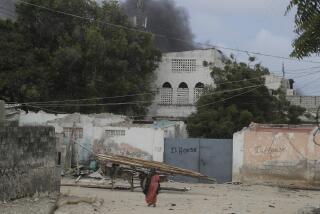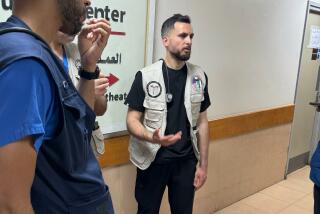Behind the Story : Danger at Ground Zero : In the daily violence of Mogadishu, the capital of Somalia, death now comes all too easily.
- Share via
MOGADISHU, Somalia — The horrifying staccato of news reports from this ruined and chaotic city can be numbing--ambushes of U.N. and U.S. soldiers, mob violence and shootings of civilians, the hunt for a wily warlord. But nothing can convey the danger like the tales of those at ground zero. Here are some of their stories:
A Harbor Master’s Tale
Eddie Johns was relaxing over a chocolate milk the other day, occasionally whacking another bug with his desk-top fly swatter as he tried to explain why he quit the U.S. Army, left a good port-captain job with Exxon and moved into a tiny room at the epicenter of an East African war zone--putting his life on the line in a ruined nation as much at war with itself as it is with those trying to save it.
“The challenge,” said the 46-year-old American harbor master, who is under civilian contract with the United Nations to build a profitable, full-service international seaport for the Somalis.
“I’ve always been the ‘fireman.’ It’s not by design. It’s just worked out that way,” Johns said. “But here’s a chance to really see one through. It’s like my wife says, I’ve worked my whole life to be here.”
Three days later, his life almost ended here.
In fact, Johns and the daily nightmares that have come with his quiet role in Somalia’s resurrection provide a glimpse of the characters and brutal irony that abound in this, the most ambitious U.N. mission ever--a $1.5-billion multinational operation to pacify and rebuild a nation still wallowing in its own self-destruction.
In describing the biggest obstacle to his task that recent afternoon, for example, Johns said, smiling wryly: “Weapons.”
It seems he’s outgunned.
In a city awash with assault rifles, mortars, land mines and machine guns and besieged by a disgruntled and determined clan militia, Eddie Johns said he could not get U.N. approval to arm his port policemen with pistols. As a result, robbery plagued the port. Not to mention, he added, problems with his own personal safety.
“They won’t even let my bodyguard carry a pistol,” he said.
Then, as if scripted, just days after this interview, Johns was driving down the busiest street in Mogadishu to a meeting at the U.N. headquarters when Somali gunmen apparently targeting his Land Cruiser pumped three bullets into its side, killing two Somali bystanders across the street and narrowly missing Mogadishu’s new harbor master.
Just another ambush, the brief news item would read later that day, in one of the most dangerous cities on Earth.
A Gruesome Exhibit
The young Somali man was doing a little dance outside the front gate of the Al Sahafi Hotel, a compound housing journalists that has become the outside world’s only independent eyes and ears on the United Nation’s mission in Somalia.
This was the day that a remote-controlled bomb had killed four U.S. Army military policemen on routine patrol just a few miles from the hotel. And the young man at the gate was clearly a loyalist of the renegade Somali warlord who has declared war on the United States and the United Nations: Mohammed Farah Aidid. The clan leader is being hunted for ordering the massacre of 24 Pakistani peacekeepers in June and staging a hit-and-run terror campaign against U.N. forces ever since.
The young man had come on a pilgrimage of proof, an almost-daily visit to the Al Sahafi by Aidid loyalists to report on “atrocities” by the United Nations the previous night or the latest pronouncements by Aidid from his underground hideouts in a city far too dangerous for journalists to roam.
But the proof the young man offered that day was grisly testimony not only to the depth of Mogadishu’s daily horrors but to the ambiguities behind the sterile headlines and pedantic Washington analyses that have punctuated the U.N.’s first-ever peacemaking mission.
As he danced and chanted, the young man held a stick in his hand with skewered bits of flesh--pieces, he said, of the American soldiers killed by the bomb blast just hours before.
In a city of lies and lawlessness, there was no way to verify his claim.
Welcome to Hotel Hell
A sniper shot cracked the evening air from the open-air cinema across the street. To the south, the sky filled with orange flares and the occasional thud of mortar fire around the two remote--and often besieged--U.S. Army supply depots dubbed Hunter Base and Sword Base.
And, from the blackness overhead, there was the intermittent, nightlong thunder of U.S. Blackhawk helicopters piloted by night scopes and armed with belt-fed machine guns--the United Nation’s “eyes in the skies” over Mogadishu.
It was a typical night on the roof of the Al Sahafi--indeed, the safest vantage point to monitor Mogadishu by night for the handful of international news organizations that remain committed to a presence in Somalia.
The hotel, which opened for business with mattresses on the floor and tarantulas in the closet a few nights before the U.S. Marines’ celebrated landing on the shores of Mogadishu last December, has been transformed into a modern establishment, complete with air-conditioned rooms and satellite dishes on the roof. But now, few of its 50 rooms are occupied.
True, the Al Sahafi remains a rare--though fragile--oasis of safety in the heart of southern Mogadishu, the district that is home both to the United Nation’s vast mission headquarters and to most of Aidid’s guerrilla forces.
But the hotel’s rooms also abound with images that explain its current low occupancy rates.
There are bullet holes in a few of the rooms and along a stairwell that takes stray rounds during the occasional firefights among bandits, Aidid’s gunmen and U.N. troops on the busy street outside.
And, in the room that serves as the office of Reuters Television, the London-based network that keeps assigning cameramen and producers to Mogadishu despite the deaths of three of its own last month, there is a bulletproof vest with a history. Dan Eldon, a 22-year-old Reuters reporter and photographer, stripped it off to run faster from an enraged Somali mob that beat him and three other Western journalists to death after a U.S. air strike on Aidid’s command center.
“No one,” explained a Reuters crewman, “will wear that vest ever again.”
In a Time Warp
U.S. Army Col. Artie Shelton was having lunch in the 46th Field Hospital’s inflatable mess tent recently, two days before his scheduled return home. He was reflecting on his four months as the commander of the medical tent city that has saved so many lives--and attempted to save so many more--from so many countries during the U.S. and U.N. military missions in Somalia.
A veteran physician, Shelton was chief of the Pentagon’s medical center in Washington when the U.S. Army sent him to Somalia on April 21. His task: To run the highly specialized and sophisticated field hospital, a facility that over the months has treated nearly as many Somalis wounded by U.N. forces as U.N. personnel wounded by the Somalis.
Before he came to Mogadishu, the colonel said, he had treated more gunshot wounds than he cared to remember during his decades of military duty in Washington and elsewhere.
And still, tears came to his eyes when he recalled the day Dan Eldon’s beaten and battered body arrived at the 46th last month--”My God,” said the colonel, who knew the young journalist well from his many hospital visits to interview the wounded. “What they did to him, the way they killed him, I mean, I didn’t even recognize Danny that day.”
Shelton pushed away the tears and then explained in his own terms how dangerous Mogadishu has become in the months since May 4, when the U.S. Marines turned over command of the peacekeeping force to the United Nations.
In recent weeks, he said, he and his staff have been busy digging sandbagged bunkers outside the hospital tents--bomb shelters where they move the patients during Aidid’s occasional mortar attacks on the U.N. compound that houses the hospital.
And yet, it was from that ringside seat of Somalia’s nightly and daily brutality that Shelton said: “The majority of Somalis really are good people. There’s a just a few bad ones. I go back to the L.A. riots. There’s always a few you have that create problems.”
But it was from that same perspective that he added: “I’ve probably seen more death in my four months here than in my 20 years in medicine.”
More to Read
Sign up for Essential California
The most important California stories and recommendations in your inbox every morning.
You may occasionally receive promotional content from the Los Angeles Times.










